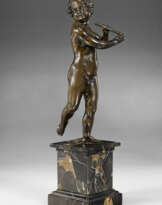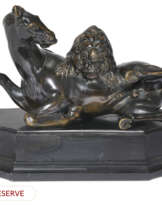PREMIÈRE MOITIÉ DU XVIE SIÈCLE, PARFOIS CONSIDÉRÉ COMME FRANÇAIS OU ATTRIBUÉ À BARTHÉLEMY PRIEUR (BÉZIEUX 1536-1611, PARIS)
21.11.2024 16:00UTC +00:00
Classic
Verkauft
88200EUR € 88 200
| Auctioneer | CHRISTIE'S |
|---|---|
| Veranstaltungsort | Vereinigtes Königreich, London |
| Aufgeld | see on Website% |
Archiv
Die Auktion ist abgeschlossen. Es können keine Gebote mehr abgegeben werden.

ID 1336090
Los 17 | PREMIÈRE MOITIÉ DU XVIE SIÈCLE, PARFOIS CONSIDÉRÉ COMME FRANÇAIS OU ATTRIBUÉ À BARTHÉLEMY PRIEUR (BÉZIEUX 1536-1611, PARIS)
Schätzwert
€ 20 000 – 30 000
Jeune homme debout également appelé Narcisse
bronze, reposant sur un socle postérieur en bois mouluré
H. 21,6 cm (8 ½ in.), H. totale : 28,8 cm (11 3/8 in.)
Provenance
Marquis de Pompignan ; vente Hôtel Drouot, Paris, 19 avril 1928, lot 78.
Alexander von Frey ; vente Sotheby's, Londres, 8 décembre 1988, lot 105.
Avec Daniel Katz Ltd, Londres.
Collection Züblin, Suisse.
Avec Patricia Wengraf Ltd, Londres.
D'où acquis directement par Claudia Quentin, 2000.
Exhibited
New York, The Frick Collection, European Bronzes from the Quentin Collection, 28 septembre 2004-2 janvier 2005, pp. 108-115, no. 8.
Further details
A BRONZE FIGURE OF A STANDING YOUTH, ALSO KNOWN AS NARCISSUS, FIRST HALF OF THE 16TH CENTURY, SOMETIMES CALLED FRENCH OR ATTRIBUTED TO BARTHÉLEMY PRIEUR
The model seems to derive from a Roman copy of a Hellenistic marble statue of Narcissus or "Génie du repos éternel", now in the Louvre, which was brought to France by Cardinal Mazarin in 1639 (inv. No. MR 207). While the date of the discovery of the antique Narcissus is unknown, it has been suggested that Michelangelo was inspired by it when he made a drawing of the Dying Slave (now Florence, Uffizi, inv. No. 608ER), thought to relate to the project for Julius II's tomb.
In European Bronzes from the Quentin Collection, Patricia Wengraf outlines the widely varying attributions proposed for this model which historically identified it with Francesco da Sant'Agata or Vittore Camelio. Subsequently Manfred Leithe-Jasper favoured an early Italian line of attribution for the model.
In 1988, Laura Camins ascribed a similar cast to the workshop of Barthélemy Prieur. Prieur was working in Rome in 1559 together with Ponce Jacquiot and probably returned to France in 1567, or in any event before his marriage in September 1571. The earliest documented appearance of this model in 1693 in the collection of André Le Nôtre, describes "Item, une petit figure de bronze representant un Petit adollessent qui a ses bras sur la teste...". This entry is followed almost immediately by two models which are called Barthélémy Prieur. The French provenance of many casts of the Standing Youth indicates that the model was certainly reproduced in France, and circumstantial evidence indicates that an attribution to Prieur is plausible.
Please note a scanned copy of the full catalogue entry from the catalogue of the 2004 Quentin Collection exhibition at The Frick Collection, New York, is available upon request.
| Künstler: | Barthélemy Prieur (1536 - 1611) |
|---|---|
| Angewandte Technik: | Metallkonstruktion |
| Material: | Bronze |
| Herkunftsort: | Westeuropa, Frankreich, Italien, Europa |
| Kategorie des Auktionshauses: | Skulpturen, Statuen & Figuren |
| Künstler: | Barthélemy Prieur (1536 - 1611) |
|---|---|
| Angewandte Technik: | Metallkonstruktion |
| Material: | Bronze |
| Herkunftsort: | Westeuropa, Frankreich, Italien, Europa |
| Kategorie des Auktionshauses: | Skulpturen, Statuen & Figuren |
| Adresse der Versteigerung |
CHRISTIE'S 8 King Street, St. James's SW1Y 6QT London Vereinigtes Königreich | |
|---|---|---|
| Vorschau |
| |
| Telefon | +44 (0)20 7839 9060 | |
| Aufgeld | see on Website | |
| Nutzungsbedingungen | Nutzungsbedingungen |











